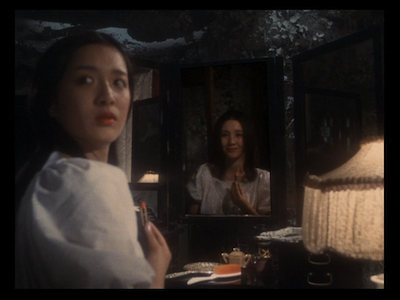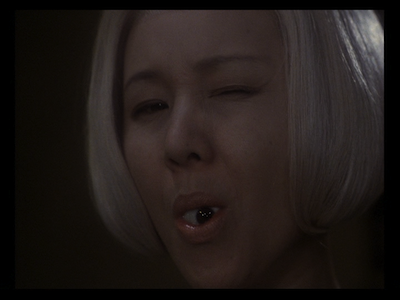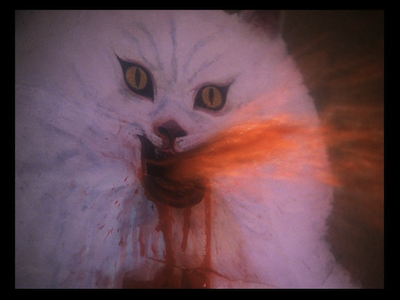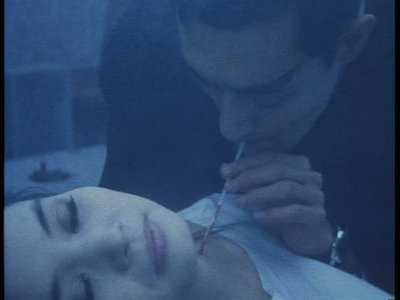
It's rare that a movie leaves me completely dumbfounded. Anyone who has spent any time reading this blog knows I can go on at length regarding just about anything, whether I know what I'm talking about or not. All the more amazing, then, that when it comes to the 1977 Japanese horror freak-out House (a.k.a. Hausu), it's impossible to know where to begin.
Directed by Nobuhiko Obayashi (Sada

The "plot" is one pulled out of the classic horror story handbook. Gorgeous (Kimiko Ikegami) is a high school student looking forward to summer vacation with her classmates, but her father, a film composer, has just returned from Italy ("Leone said my music was better than Morricone's") with a new bride to replace Gorgeous's long-dead mother. Distraught by the sudden life upheaval, Gorgeous decides to visit her aunt at her country home. When the plans for the other six girls also get derailed, Gorgeous invites them along.
The girls in the movie are like the seven dwarves, reduced to the types we normally expect in slasher pictures. In addition to Gorgeous there is Fantasy (her head is always in the clouds), Prof (she's really smart), Melody (likes music), Mac (likes to eat), Sweet (always nice), and Kung Fu (what do you think?). There is also a mysterious white cat named Blanche that appears just as Gorgeous informs the aunt of her impending arrival. Blanche is a signal of what is to come. The name has to be an intended allusion to A Streetcar Named Desire

Anyway, Auntie (Yôko Minamida) had a lover who was a pilot in the war. He went off to fight, never came back, and things have never been the same again. She has lived a life alone with her cat, numerous portraits of the fluffy creature covering the walls where family pictures would otherwise be. Her past is told as a silent movie, complete with title cards, and narrated by the girls themselves, as if they were watching it rather than just hearing Gorgeous tell the story. It's during a train ride, which itself looks like some idyllic marketing campaign come to life. The other passengers include a nun, a sailor, and a guy reading a book about horror movie monsters--the kind of diversity that would make any ad agency proud. (Indeed, Obayashi was a commercial director and responsible for the Charles Bronson cologne ad recently doing the internet rounds.) The train station also has many matte paintings that Obayashi uses as tricky trompe-l'œils, challenging our perception of reality. Is it any coincidence, then, that all the shots of the sky outside Auntie's house are matte paintings as well?

It's hard to say, actually. Maybe it is a coincidence. It's impossible to tell whether anything in House is there by design. It stands on a line between an authentically bad movie and a hilariously intentional one. There are scenes of slapstick mixed in with some gore; there is lurid B-movie leering alongside heartfelt romance. Some of it is so completely gonzo that you can't believe Obayashi isn't playing a prank, such as the way the stepmom's scarf is always blowing behind her. Yet, I think House is a sincere effort. It's the small details where a director truly reveals himself. What tipped it for me was the appearance of Andrew Wyeth's famous painting Christina's World in Gorgeous's bedroom. It's an image of a girl in a wheat filed, on the ground, half rising half sitting, her back to the audience, looking at a house on a hill. Painted in 1948, it has inspired much debate about who the girl is, where she is, why she is staring at the house. Does she see a hopeful life there? Or does she dread returning?

There are tons of stray details in House. Every frame is packed with something, and if you don't let your eyes rove over the images, you might miss some of the odd touches. Objects move and come to life, things appear and disappear--you have to keep looking. Obayashi employs editing tricks to create loopy effects, as well as old-fashioned Fangoria gore, dumping buckets of blood on the floor and tossing rubber limbs around. Sam Raimi was 18 when House came out. I don't know if he's ever seen the movie, but one can easily picture him wandering into a theatre somewhere as a teenager and having his mind blown. For all the laughs and the what-the-hell? moments, there are some isolated scenes in House that are also genuinely scary and generally brilliant. The many inspired uses of severed body parts alone are enough to keep you up at night.

House is such a bizarre curio, it's hard to imagine both why it has been buried for so long and why whoever was responsible didn't bury it deeper. I'm so baffled and in awe, I don't actually want it explained to me, there's no way a director's commentary could do it justice. It's a movie that just needs to be seen. It can only speak for itself, no matter how much I want to keep telling you more. You just have to see it.

The above was written eight months ago when I saw the movie as part of its theatrical tour. Now having had a chance to revisit it on DVD, my appreciation has only grown--particularly due to the presentation of the movie on this disc. I know cinema fans can get pretty dogmatic about 35mm prints, but I have to say, straight-up, the DVD is ten times better than the print I saw of House. The clarity here gave me a whole new appreciation of the special effects, particularly the masterful background paintings. Obayashi has created a colorful fantasy world, and the depth of field in his soundstage constructions are astounding. The in-camera special effects also are only improved by the digital resolution. House is creativity unleashed, and Criterion has given the movie the best possible arena to show what its got.

Obayashi was already developing his scattershot style back in 1966, as evidenced by his 40-minute experimental film, Emotion, included here as a bonus. In Emotion, the director is both toying with the idea of making a horror movie and with the whole notion of making movies in general. The film starts with a declarative introduction, and a credits sequence that is like a scrapbook for the production. Voiceover alternates between English and Japanese--presumably by design, though it ends up sounding like one of those television programs for bilingual nations. There is even some French narration.
The story of this short film is about two girls, Mari and Emi. Mari is the daughter of vampire parents, and Emi is from the sea. They become friends, and they run afoul of some dangerous men. Emi also has a run-in with Mari's vampire mother. Emotion is a pop art parody of scary films, spaghetti westerns, and French cinema; it's dedicated to Roger Vadim, and it even has a touch of his trademark naughtiness. Thematically, human desires are what lead to grotesque horrors, and nature itself has a pull on our actions. Full moons bring werewolves, naturally, but here Obayashi seems to be using the oceans and tides and the pull it has on women's bodies as a metaphor to explore the dangers one encounters on the path to adulthood.
Emotion is shot in color, regular black-and-white, and tinted black-and-white; Obayashi employs stop motion and manipulates cut-outs and paper. He also lets the camera crew wander into the scenes and talks about his dreams for making a real Dracula movie one day. This leads to a coda, where one of the girls' boyfriends has now crossed over to the other side. It's the closest to traditional horror as we'll see from Obayashi, with the bloodsucker roaming a misty graveyard at night. Of course, he drains the precious liquid from a girl's neck with a straw, so it's not all normal. Still, there is something practical about the idea....

The other major extra deals with the inception of House and what it took to get it made. A 45-minute compilation of new interviews with Nobuhiko Obayashi, his daughter and inspiration Chigumi Obayashi, and screenwriter Chiho Katsura illuminated the long process that began with Obayashi, a successful commercial director, being charged by Toho to come up with a Japanese movie like Jaws
Other extras include a short video appreciation by House of the Devil
This disc was provided by the Criterion Collection for purposes of review.

2 comments:
One wonders if Edgar Wright is a fan of Hausu.
Have you ever thought about publishing an e-book or guest authoring on other websites? I have a blog based on the same subjects you discuss and would really like to have you share some stories/information. I know my viewers would value your work. If you are even remotely interested, feel free to shoot me an e mail. House of horrors
Post a Comment